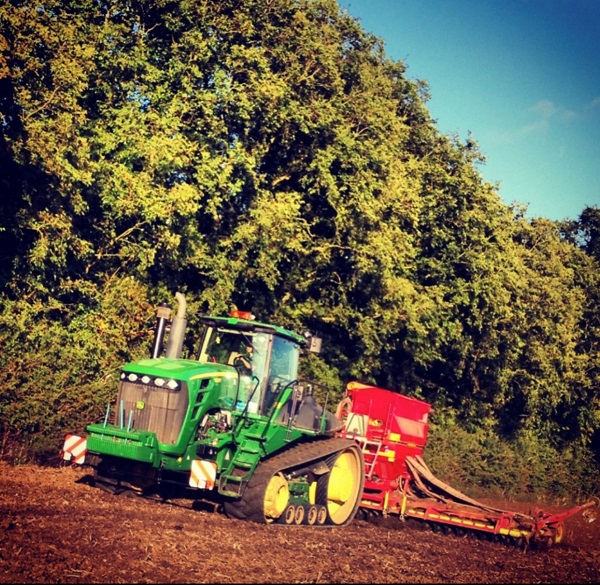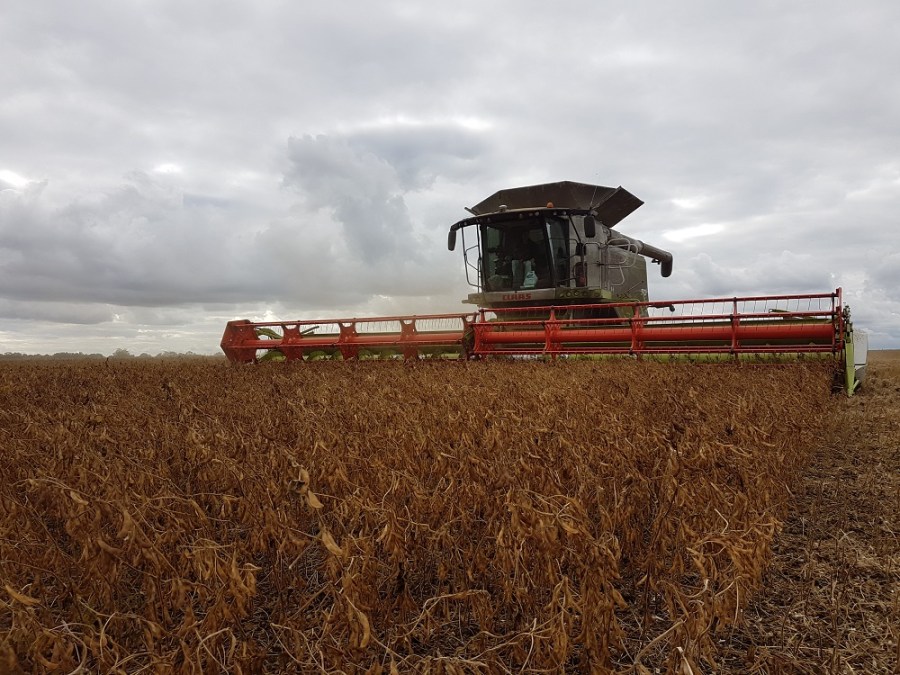Soya beans have proved to be an attractive alternative to oilseed rape for one progressive and highly professional family farming business on the Essex/Herts border. CPM reports.
Some farmers reckon that soya beans are risky, but for us the risk is low in comparison to producing OSR.
By Julian Cooksley
The last time CPM visited MJ and SC Collins who farm 1200ha at Matching near Harlow, it was to profile the farm’s approach to growing oilseed rape. But you won’t find a trace of the crop now.
The increasing risk of damage from cabbage stem flea beetle means that many farmers are now looking for a lower-risk alternative to OSR, according to Amanda Owen, seed buyer for Fram Farmers. The farmer-owned co-operative provides the purchasing, grain marketing and administrative function for more than 1200 forward-thinking farming businesses who collectively farm over 270,000ha throughout the UK.

Correct drilling depth is essential to ensure that soya beans germinate evenly.
“As well as selling farm inputs we have a team of experts who offer unbiased information and advice, aimed at providing cost-saving and other benefits for members that even large farming businesses which employ a dedicated buyer can’t match,” she explains.
It was a change in cropping strategy that was needed for one of its members, MJ and SC Collins three years ago. Having grown their first crop of soya beans in 2016 they’re now the UK’s largest producer.
“OSR was very profitable for over 20 years,” farm manager John Haynes states. “At one point we grew 350ha and could confidently budget for a yield of 4t/ha, but the ban on neonicotinoid insecticides meant that flea beetle damage became a major issue. In recent years, yields dropped to the point where we would have needed over £500/t to continue growing the crop and controlling pigeons was a full-time job from Oct to March.
“OSR became increasingly expensive to grow and the fact that a large percentage of the costs were incurred early on amplified the risk. The tipping point came in 2016 when we had to irrigate 24hrs a day for three weeks during the very dry summer in an attempt to establish the crop. This massively increased our costs, but CSFB ate the crop faster than it grew, so we got nothing in return. We concluded that the risks of growing OSR were no longer worth taking.”
In 2017 the management team at MJ & SC Collins decided to replace OSR and winter beans (which produced inconsistent yields), with Sugar Beet and soya beans. They planned to grow 16ha in the first year to assess the crop’s potential, but eventually drilled 80ha, and in 2018 increased the area to 122ha. This year they’ll grow 170ha.
“Some farmers reckon that soya beans are risky, but for us the risk is low in comparison to producing OSR,” John states. “However, we did research the crop thoroughly and identified three main risks: correct establishment, pigeon damage and late harvesting.
“Soya beans need well-drained, well-structured land and suit our Hanslope Series soils. Correct establishment is essential, and we prepare the land thoroughly in the autumn to 20cm deep using a Vaderstad TopDown. The first season we drilled soya beans straight into over-wintered tilth with an 8m Vaderstad Rapid at 15-16km/h, in year two we used a light spring-tine cultivator ahead of the drill and this year we’ll run an 6m Farmet Kompaktomat ahead of the Rapid.
“Initially, we used a seed rate of 130kg/ha, as Soya UK recommended, and the crop looked good until July, when 60% was badly damaged by a freak hail storm. It was too late to plant anything else, so we left it to see what would happen and were surprised that the damaged area recovered remarkably well, yielding 1.6t/ha versus 2.6t/ha for the remainder. That yield would have been higher but for the fact that the crop received only 14mm of rain after sowing through until harvest.
“In 2018 we drilled just one variety, Siverka, at 150kg and waited for the right conditions rather than drilling on a set date. There’s no great yield penalty from late sowing, but it’s essential that soya beans are drilled 25-30mm deep as they have a fixed-length hypocotyl and won’t emerge if sown too deep. We’ve used variable rate seeding for several years and will extend it to soya beans this year.
“Pigeons ‘go nuts’ for soya beans and a consistent sowing depth is essential to ensure that they emerge evenly and minimise the time that control measures are needed. If achieved, the critical period lasts only two or three weeks in mid- to late May, which is much less onerous and costly than for OSR. However, pigeons must be controlled from first light to dusk, so during that period we operate a rota system using shooting and bird scarers.
“The final major risk to the crop is a late harvest, but harvesting is very quick because the volume of material is low. Our 12.3m Claas Lexion 770TT operates at 8 – 10 km/h and can harvest all the soya beans that we grow in a day and a half. In year one we harvested on 6 Oct, later than expected as the dry summer restricted development. We finished harvesting in the rain, which increased the moisture from 15% to 16.7% but made the job much easier. Late harvest is aided by the fact that if conditions are moist the oily pods and seed are actively moisture repellent, offsetting the calendar date somewhat compared to any other crop left to harvest at this late stage.”
Last year the severe drought caused the crop to die off prematurely and it was harvested in mid-Sept, but still averaged 1.6t/ha. “We were relatively pleased, and it proved how resilient soya beans are versus other alternatives. We’re looking forward to 2019 and have budgeted for 2.5t/ha,” notes John.
Soya beans are a relatively cheap to grow, he says, and need no additional nitrogen, but are sensitive to trace element deficiencies, so he applies a mix containing cobalt, manganese, copper, boron, potassium, zinc, molybdenum, sulphur and magnesium. Only one pre-emergence herbicide, Nirvana (pendimethalin+ imazamox) is needed because the thick canopy outcompetes weeds. If necessary, he applies a graminicide and low-cost sulfonylurea (SU) herbicides for post-emergence control of weeds such as charlock.
“We see a great future for the crop in the UK, because customers want a consistent supply of non-GM soya beans, and more farmers growing them will help this market. This year we’ll have 170ha, about half the 350ha that, theoretically, we could grow, but the full area would increase the harvesting risk. In addition, the relatively small UK market means that there are no LIFFE futures, so we can’t hedge. We would turn to the CBOT-traded soya bean futures, but our domestic price and Chicago futures don’t move completely in tandem.”
Business profile – MJ and SC Collins
Michael and Christine Collins formed the partnership in 1961. Following the compulsory purchase of their farm where the town of Harlow now stands, they moved to Kingstons Farm at Matching near Harlow. By the 1980s the business had expanded from around 100ha to over 400ha, growing cereals and ever more potatoes in addition to 28,000 egg-laying chickens, a 250-sow pig-breeding herd and 650 beef cattle. The business employed 17 staff.
When Simon and Jane Collins joined the partnership, they continued to build on earlier successes. By the 1990s livestock production ceased because it was no longer profitable, but the area of the arable crops increased to over 690ha. This included a 220ha potato enterprise producing pre-pack potatoes for the supermarket trade and export potatoes for tourists in the Canary Islands, for which extensive irrigation and cold storage facilities were created.
Diversification has played a major role in shaping the business to how it is today. Given the fortunate location of the business within the M11 motorway corridor growth area, and its proximity to both London and Stansted airport, redundant farm buildings from livestock and potato production have been converted into a wide range of over 50 business units as storage warehouses and for light to medium industrial use to serve the business community.
In the early 21st century, due again to changing market demands, potato production became less viable and production ceased. However, the agricultural side of the business grew rapidly with a simplified cropping plan of wheat, barley, soya beans and sugar beet spread over more than 1200ha of East Herts and West Essex. Today, MJ and SC Collins produce a variety of wheats, including Group 1 milling, Group 2 hard and Group 3 soft biscuit wheat. Due to advances in crop production techniques, the farming business now employs four full time staff and that number doubles during the busy summer and autumn months.
The majority of the land farmed over three main sites is owned. Following the purchase of Lysander Park in 2006, the latest additions to the farm have been at Dane Bridge, Much Hadham and Greensted, Ongar. The remainder of the farming area is made up of rented and contract farmed land.
Simon and Jane’s son Peter, a third generation of the Collins family, became a partner in the business in 2017. Today, he is involved both the commercial and agricultural side of it to continue the momentum of the business, which continues to seek to further expand in all areas of its activities. He works very closely with farm manager John Haynes to market all 18,000t of agricultural crops produced each year and has introduced various instruments such as options, futures and currency hedges to help the business operate as efficiently as possible.
Peter also works closely with his father Simon, who oversees both the agricultural and commercial sides of the business. Simon has an active, dynamic approach to agriculture and has benefited from seeing several cycles within the industry over three decades. Providing help from the office including cropping decisions and variety choices, to getting ‘hands on’ during busy harvest periods, he remains an active partner.
To make the most of economies of scale and the farming as efficient as possible, each farm is split into 160ha blocks to compliment the fleet of high output machinery and ensure that work is carried out as quickly as possible, at the right time. Each farm has its own grain storage facilities with enough capacity to hold all the farm’s produce, which gives the business more control over harvesting and marketing.
Agronomy is provided by Prime Agriculture and overseen by John, with the aim being to apply the most up to date agronomic science and technology in exactly the right place right across the farm. This ensures that attention to detail is applied on a large scale.
Improving soil health is viewed as the cornerstone of the business’ future agricultural development – the key areas here are the incorporation of treated biosolids to improve nutrient status, soil organic matter and workability, improving soil drainage, using GPS RTK technology to align machine widths in the field and adopting a Reduced Traffic Farming (RTF) approach.
Peter Collins (left), a partner in MJ and SC Collins, with John Haynes. John joined the business in 2011 after working as a farm manager for Velcourt on the Suffolk Coast. BASIS and FACTS qualified, John’s responsible for all aspects of the farming side of the business and is always looking for ways to improve and expand the agricultural sector. Keen to support the next generation, John is a member of Fram Farmers’ Next Generation Council, which was established in 2013 to provide a positive, stimulating group for those reaching the end of the time with Young Farmers




